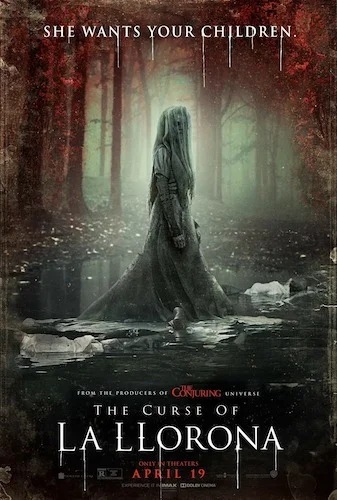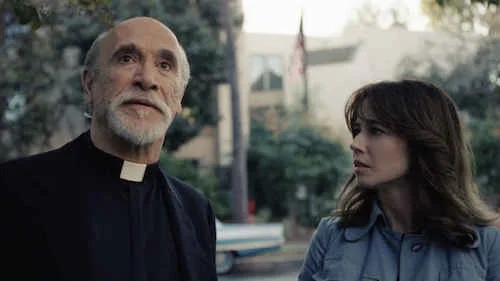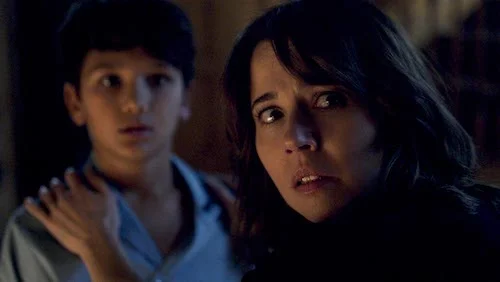The Curse of La Llorona
It isn’t difficult to see why Michael Chaves might be on to something with The Curse of La Llorona, but is unsure of how to finish his ideas. Chaves is an editor and visual effects artist that is now taking part in directing two segments of the Conjuring universe (the next series threat to try and overthrow Marvel, I’m sure; why are there so many of these films, anyway?). The difference is La Llorona is only somewhat linked to The Conjuring and its affiliate films, so it is able to take its own liberties. Knowing this is Chaves’ feature length debut, it all makes sense as to why this film has some neat foundations, and yet it fails altogether.
In short, La Llorona feels like a demo reel fit enough to show in theatres. Every jump scare is creative: the reflection in the interior of a car window, the ghastly image seen through an umbrella, that kind of thing. However, none of these jump scares work for two main reasons. The film is so obsessed with parading these moments in a row, it’s as if it is a gambit to get you to remain scared the entire film; we instead get used to the repetitive formula. Secondly, the film doesn’t create an actual atmosphere, which is too bad because the somewhat intriguing score by horror film favourite Joseph Bishara does its own work with setting a tone. In a film like Hereditary, when a haunting image is presented without frills, it’s a sight that stays with you. Every scary moment in La Llorona is either meant to make you leap, or is a lead-up to another jump scare. It gets tiresome, like committing to super hot cheetos as a diet for every meal for a week. There may still be a kick, but it’s old news very quickly.
Anne with Father Perez discovering who La Llorona is.
All of the right pieces are here, and that’s what makes this film even more bothersome. You have a piece of Mexican folklore (about the haunting ghost of a mother who killed her own children), and the topic of domestic abuse being slightly present here (a current social discussion mixed with an urban legend? It should have been at least stirring). There’s also the nth degree caused by grief, including an interesting scene of a heartbroken mother wishing the social worker that tried to save her kids lost her own children instead. It’s dark, but that’s where the human mind goes sometimes.
Nope. We start with the modern horror jump scare fiasco right from the beginning. If it’s a device used to set a tone before the long moments of backstory, that would make sense. That is not the case. La Llorona has so many of these damn moments, I would try to jot down some notes and couldn’t even finish a thought before another jump occurred. This film does not get the concept of “fool me once”. A jump only works if it is unexpected, or it is at least earned.
Social worker Anne feeling the ghost of La Llorona nearby.
I went in expecting very little of this cliché-ridden horror film, one meant to make you spill your popcorn over eventually (at all costs, evidently). I left actually disappointed. It isn’t because the film was even worse than expected. It’s because it surprisingly could have at least been decent. An hour and a half was not enough time here. If the film needs this many jarring moments (which are at least imaginative), there had to be a prioritization of time for cooling down to occur. There is a timely discussion evident, but it doesn’t get explored as well as it could (it becomes just a slight nag that Anne is painted out to be an abusive mother, more than it is a legitimate threat). Since this film is a part of the Conjuring universe, it’s time to remember why the first iteration is actually decent. It also contains a plethora of jump scares, but a good portion of the film is devoted to situation creation (at least for the first act). Each subsequent scare becomes a stepping stone towards a deeper nightmare. Here, it’s an obstacle course of trying to get out of the film.
The ideas are wasted. The stirring score is wasted. Linda Cardellini’s strong performance is wasted. The great child performers are wasted (believe me, truly talented kid performers are completely understated, especially in horror films). This isn’t even the league of disappointment where you can revisit these ideas again out of intrigue and appreciation. It all just gets tossed to the wayside, because La Llorona had to be commercialized. It had to be a bitesized length. It had to carry the mediocre-horror-check-list and follow every requirement. It had to be hinged to an existing horror franchise, despite the origins being of a much larger (and arguably greater) magnitude. The Curse of La Llorona is not the maternal apparition in the film, but the many sterilizing tribulations horror films continuously have to be stymied by.
Andreas Babiolakis has a Masters degree in Film and Photography Preservation and Collections management from Ryerson University, as well as a Bachelors degree in Cinema Studies from York University. His favourite times of year are the Criterion Collection flash sales and the annual Toronto International Film Festival.






